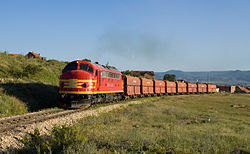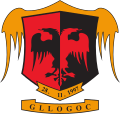Drenas
 From Wikipedia - Reading time: 11 min
From Wikipedia - Reading time: 11 min
This article needs to be updated. (May 2022) |
Drenas
Glogovac | |
|---|---|
Town and municipality | |
| Coordinates: 42°37′25″N 20°53′38″E / 42.62361°N 20.89389°E | |
| Country | Kosovo |
| District | Pristina |
| Municipality | Drenas |
| Government | |
| • Type | Mayor–council |
| • Mayor | Ramiz Lladrovci[1] (PDK) |
| • Council | Drenas Municipal Council |
| • Chairman | Milaim Hajdari[2] |
| Area | |
• Municipality | 275.63 km2 (106.42 sq mi) |
| • Rank | 22nd in Kosovo |
| Population (2024)[3] | |
• Municipality | 48,054 |
| • Density | 170/km2 (450/sq mi) |
| • Ethnicity | |
| Time zone | UTC+1 (CET) |
| • Summer (DST) | UTC+2 (CEST) |
| Postal code | 13000 |
| Area code | +383 (0) 38 |
| Vehicle registration | 01 |
| Website | kk.rks-gov.net/drenas/ |
Drenas or Gllogovc/Gllogoc (Albanian definite form: Drenasi or Gllogovci/Gllogoci), or Glogovac (Serbian Cyrillic: Глоговац), is a town and municipality in the District of Prishtina in Kosovo. The municipality has an area of 276.63 km2 (106.81 sq mi). According to the last census of 2024, the municipality has a population of 48,079.[4]
History
[edit]The municipality was established before World War II as a distinct social, political, and administrative unit. Over the past eighty years, economic development has been very limited, as previous governments, directed from the central authorities of Yugoslavia, largely neglected the municipality.
Historically, Drenas was focused on extensive agricultural development. In the 1970s, the first initiatives for economic development in Drenas began to emerge. These efforts were accompanied by urban spatial development as well.
In 1981, the settlement of Drenas was officially declared a town, becoming the main administrative, cultural, social, and municipal center of the area.
Before and during the Kosovo War (1998–1999), the ethnic Albanian separatist organization, the Kosovo Liberation Army (KLA), held significant influence and managed to control large parts of the municipality. Drenas as part of the Drenica region, the municipality was heavily affected by the conflict. During the war, forces of the Federal Republic of Yugoslavia were responsible for several massacres in the area. Mass graves were later exhumed in an attempt to conceal crimes.[5][6]
Geography
[edit]Drenas municipality is located in central Kosovo, between the Çyçavica mountains in the east and the Drenica hills in the north and west. The main road from Prishtina to Peja crosses the municipality. At a junction at Komorani village, a smaller road extends north from the highway, passing through Drenas town and continuing to Skenderaj.
Climate
[edit]Drenas has a humid subtropical climate (Cfa) as of the Köppen climate classification with an average annual temperature of 11.1 °C (52.0 °F).[7] The warmest month in Drenas is August with an average temperature of 22.4 °C (72.3 °F), while the coldest month is January with an average temperature of 0 °C (32 °F).[7]
| Month | Jan | Feb | Mar | Apr | May | Jun | Jul | Aug | Sep | Oct | Nov | Dec | Year |
|---|---|---|---|---|---|---|---|---|---|---|---|---|---|
| Mean daily maximum °C (°F) | 4.1 (39.4) |
6.1 (43.0) |
10.6 (51.1) |
15.5 (59.9) |
20.2 (68.4) |
24.8 (76.6) |
27.6 (81.7) |
28.2 (82.8) |
22.3 (72.1) |
16.8 (62.2) |
11 (52) |
5.2 (41.4) |
16.0 (60.9) |
| Mean daily minimum °C (°F) | −3.4 (25.9) |
−2.3 (27.9) |
0.8 (33.4) |
5 (41) |
9.9 (49.8) |
14.1 (57.4) |
16.4 (61.5) |
16.2 (61.2) |
11.9 (53.4) |
7 (45) |
2.3 (36.1) |
−1.8 (28.8) |
6.3 (43.4) |
| Source: Climate-Data[7] | |||||||||||||
Demography
[edit]| Year | Pop. | ±% p.a. |
|---|---|---|
| 1948 | 16,177 | — |
| 1953 | 17,683 | +1.80% |
| 1961 | 21,125 | +2.25% |
| 1971 | 28,188 | +2.93% |
| 1981 | 39,141 | +3.34% |
| 1991 | 53,618 | +3.20% |
| 2011 | 58,531 | +0.44% |
| 2024 | 48,079 | −1.50% |
| Source: Kosovo Agency of Statistics[8] | ||
According to the last census of 2024 of the Kosovo Agency of Statistics, the municipality has a population of 48,079. The overwhelming majority of the population is Albanian (99.91%).[9]
Economy
[edit]Ferronikeli mine and smelter operation provided jobs for more than 2,000 people at the peak of its production in 1988.[citation needed] As of 2019, it was "the largest exporter in Kosovo, accounting for about 40% of the country's exports".[10][11] While the presence of significant ore deposits was noticed as long ago as 1958, the plant was commissioned in 1984 while the Socialist FRY was in power.[12] The deposits are of the lateritic type.[13] Heavy damages were inflicted on the facility during the 1999 conflict, leaving it inoperable. Ferronikeli was privatised after the war by Alferon Management. Since July 2018 the most recent owners are called Balfin Group, who took over the project after it had been idle for four months.[14] The plant contributes to the infrastructure of the municipality with power, including water supply and an electric grid. Four nickel mines operate in the region: Çikatova, Dushkaja, Gllavica and Suke.
Two quarries at Korroticë e Ulët and Çikatovë e Vjeter have become operational since the conflict.
A major development is the building of the Trade Centre, which was completed by mid-2004. The municipality played a central role in the whole process by co-ordinating the financing, construction and management of the project. The Trade Centre contains 134 shops and offices for small businesses.[citation needed]
Infrastructure
[edit]Since 2000, there has been a gradual improvement in economic, agricultural, educational, medical and industrial growth. Municipal development has affected the construction of network-educational system, health and service network intensifying agricultural development has become especially after the construction of the irrigation system "Iber Lepenci", while a positive movement for the economy is marked by Ferronikeli, a local mining and smelting operation.[citation needed]
In 1936 the railway from Prishtinë to Peja was completed, which passed through the town of Drenas.

Media
[edit]There are two Radio Stations, "92.1 Capital FM" broadcasting on a regional coverage, and "Radio Dodona" of which at the moment is not operating for unknown reasons, and there is a local TV station "Star TV" broadcasting on cable only.[when?]
Sports
[edit]Notable people
[edit]- Izet Ibrahimi – Former Mayor of Drenas, Phd of Metallurgy
- Jakup Krasniqi – Former Chairman of the Assembly of Kosovo
- Rifat Kukaj – Notable Poet, Writer for Children
- Iljaz Prokshi – Novelist
- Rainer Wieland – Vice President of the European Parliament, honorary citizen of Drenas[15]
- Herolind Shala (born 1992), Albanian footballer, born in Norway, international player for Kosovo.
- Fehmi Lladrovci – KLA commander
- Besim Mala - KLA commander and Kosovo Protection Corps commander
- Rasim Kiçina - KLA commander
References
[edit]- ^ "Komuna – Kryetari: Kryetari i Komunes" (in Albanian). Municipalities of Kosovo. Archived from the original on 29 May 2022. Retrieved 29 May 2022.
- ^ "Komuna – Kuvendi: Kryesuesi i Kuvendit" (in Albanian). Municipalities of Kosovo. Archived from the original on 29 May 2022. Retrieved 29 May 2022.
- ^ "Population and housing census in Kosovo preliminary results - July 2024" (PDF). Retrieved 2 August 2024.
- ^ "Population and housing census in Kosovo preliminary results - July 2024" (PDF). Retrieved 21 July 2024.
- ^ "A Kosovo Chronology". PBS. Retrieved 4 July 2012.
- ^ "Serbs accused of clearing mass graves". BBC News. 18 May 1999. Retrieved 4 July 2012.
- ^ a b c "Climate: Drenas". Climate-Data. Archived from the original on 28 May 2022. Retrieved 28 May 2022.
- ^ "Population and Households by settlement, 1948-2024". Kosovo Agency of Statistics.
- ^ "Population and Households by settlement, 1948-2024". Kosovo Agency of Statistics.
- ^ "LARGEST FERRONICKEL PRODUCING COMPANY IN KOSOVO RECEIVES EBRD FUNDING". South-East European Industrial Market. TLL Media. 7 November 2019.
- ^ "DFF - Ferronikeli". EBRD. 29 July 2019.
- ^ "About us". NewCo Ferronikeli. 17 December 2018. Retrieved 3 April 2021.
- ^ Shefik Imeri; Ioannis Gaitanos; Naim Tahiraj; Musa Rizaj; Florian Kongoli (July 2013). "OPTIMIZATION OF TECHNOLOGICAL FE-NI PRODUCTION PROCESS IN NEWCO FERRONIKELI IN KOSOVO". Fray International Symposium.
- ^ Dimitrievska, Valentina (24 July 2018). "Albania's Balfin acquires Kosovo's idled Newco Ferronikeli". bne IntelliNews.
- ^ "Zu Besuch im Kosovo: Unterwegs mit Rainer Wieland MdEP, Vizepräsident des Europäischen Parlaments – Education Unlimited" (in German). 12 May 2018. Retrieved 3 September 2021.
External links
[edit]- Municipality of Drenas – Official Website
 KSF
KSF



